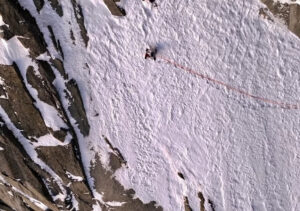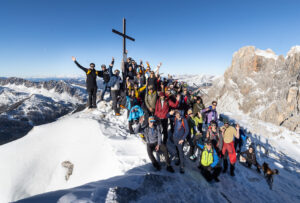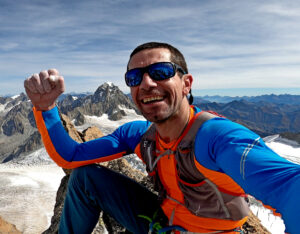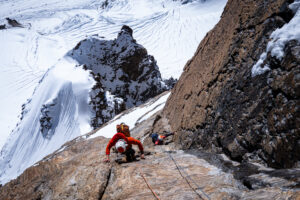“Today is day 11 of free soloing a harder route every day until I fall,” the tousle-haired young rock climber says to the camera. “And today we’re free soloing 11b.”
The view then switches to distant footage of him climbing ropeless up a steep 5.11b route in Colorado, which includes a precarious move over a short overhang.
The comments section on this footage posted to Instagram via the account Lincolnclimbs makes for interesting reading. Some praise the climber’s calmness under pressure and congratulate him. Others are understandably more negative. Free soloing is climbing without a rope, the subgenre of climbing that American pro Alex Honnold became famous for doing, very, very carefully. One commenter, in particular, raises concerns about advocating this activity.
Advertising free soloing on a social media platform is not a good thing to do as a climber. This is how we get people killed because they saw one dude do it online and they try to do it themselves. I get you’re a good climber but this is not the way to go about internet fame. You have a lot of influence and it can be good AND bad. At least do some sort of safety warning or actively tell people not to do this kinda thing.
View this post on Instagram
Next-level ragebait
Another viewer suggests the video is designed as a means to provoke anger and negativity to drive increased engagement with his social media account: “Free soloing till I fall is some next level ragebait.”
The video is part of a series of Instagram posts focused on free soloing, which started with “day one of free soloing a harder route every day until I fall” on a 5.8 graded route on June 7. Mixed around these videos are other content from free soloing buildings, to climbing disused chimney stacks.

Photo: lincolnknowlesadventures.wordpress.com
Who is the climber?
The climber behind the Instagram account is a young American college student named Lincoln Knowles. An article published on the website Voyage Utah last August suggests Knowles has been climbing for five years, is a college student in Utah, and is also a climbing guide and YouTuber.
“At just 20 years old, I am a full-time climbing guide and YouTuber, passionately sharing my adventures and expertise with a growing online audience,” he told the site.
Knowles appears to have a second, more conventional Instagram account and a personal website that advertises rock and ice climbing courses. He states that he has a Wilderness First Aid Certificate and has undergone avalanche training.
The young American is clearly a strong climber. On July 13, Knowles posted a video claiming to be the first to free solo what he describes as the longest sport climbing route in the United States — Squawstruck (5.11b, 22 pitches), a 600m climb in Rock Canyon, Utah.
View this post on Instagram
Asking for donations
Following the Squawstruck climb, Knowles posted another video referring to the successful climb with the simple caption “Venmo: Lincoln-Knowles”. Venmo is an American mobile payment service. Knowles is asking followers to make a donation.
One commenter took less kindly to this request: “Bro, imagine some semi-strong unsponsored boulderer, trad climber, or sport climber put their Venmo or Zelle on a post after FA-ing, equipping, sending, flashing or onsighting any route or climb. What are you doing my guy? Plenty of people love climbing, we ain’t paying you to do this. You need to rethink this whole strat boss.”
View this post on Instagram
Knowles also runs a Patreon account where he posts videos of his climbs, with various paid membership levels. On this page, he suggests supporters help him “stay independent, fund new missions, and tell the kind of climbing stories that aren’t sponsored, filtered, or algorithm-friendly.”
A different side
From the Instagram account alone, it would be easy to form the impression that Knowles is simply reckless. However, his longer-form YouTube videos paint a different picture. In one video entitled My Hardest Free Solo Yet (Colossus 5.10c), the young climber has inserted a voice-over where he calmly commentates through key sections of the route.
He talks about enjoying the route, the moves ahead, getting lost on the route, judging rock quality, the time it takes to learn this, and the high consequences of what he is doing.
One commenter is less forgiving, though. “This isn’t standard free solo practice. You should know the route flawlessly, not get up and realize you have no idea which way to go. And you can’t onsight something you’ve already had a go on. Please have a plan if you really feel like you need to do this. It isn’t worth dying for.”
Towards the end of the video, Knowles riffs on his reasons for free soloing.
“If you’re a climber, you kind of understand the joy behind climbing, and the feeling of satisfaction that you get when climbing. And it’s kind of reasonable to think about how the more time you spend climbing and the less time you spend managing ropes, the more actual climbing you’re doing.
“If you’ve never climbed before, I would suggest that you try it, and you’ll realize that it’s actually really good. Developing trust in your own abilities and in your feet is a really good feeling.”
Kodak courage
In the wider outdoor world, social media has played an undeniable role in luring hikers, climbers, and skiers onto terrain they may not be equipped to deal with. In 2017, the Instagram-famous Capitol Peak in Colorado, had five deaths on its slopes in six weeks.
One of the dead was amateur climber Jake Lord. Lord had persuaded his friend Peter Doro, a hiker afraid of heights, to tackle Capitol Peaks’ knife-edge ridge. The dizzying YouTube videos the pair pored over proved too alluring, the potential feeling of triumph too much to miss out on. Before the incident, Lord messaged his friends, “This is what I’m about to do, it’s going to be sick.”
Two years before Facebook launched, avalanche expert Ian McCammon published research noting six factors contributing to avalanche accidents. These included the need to do activities to be noticed or accepted by other mountain goers. This has since become known as “Kodak Courage.”

An Instagram story posted by Knowles on August 1. Photo: Screenshot
Not the only one
Kodak Courage is nothing new, but the advent of social media and its “everywhereness” has given it a new edge: the need to drive engagement for attention or monetary gain.
Lincoln Knowles is not alone. In February, a Ukrainian ice-climbing influencer known for posting risky or controversial content died in an unroped fall, after having only taken up the sport nine weeks earlier.
Knowles’ motivation for posting controversial content on free soloing is not clear from his online presence, and it is worth noting that this is a young man who appears to have a passion for climbing. Despite this, some commenters on his videos strongly disagree with his actions:
“Free soloing was never about spraying on Instagram. Dude you’re gonna look back in a few years [and] be so embarrassed at how cringe this is. Solo on your own, for yourself. Have more respect for yourself than the algorithm.”
What is clear and not open to debate, however, is that this free soloist wants your attention.






